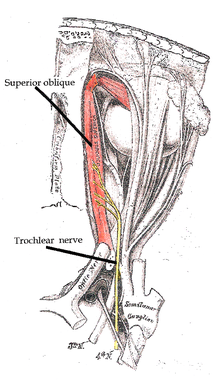| Fourth Cranial Nerve Palsy | |
|---|---|
| Other names | Trochlear nerve palsy |
 | |
| Trochlear nerve | |
| Specialty | Ophthalmology |
Fourth cranial nerve palsy or trochlear nerve palsy, is a condition affecting cranial nerve 4 (IV), the trochlear nerve, which is one of the cranial nerves. It causes weakness or paralysis of the superior oblique muscle that it innervates. This condition often causes vertical or near vertical double vision as the weakened muscle prevents the eyes from moving in the same direction together.
Because the trochlear nerve is the thinnest and has the longest intracranial course of the cranial nerves, it is particularly vulnerable to traumatic injury.
To compensate for the double-vision resulting from the weakness of the superior oblique, patients characteristically tilt their head down and to the side opposite the affected muscle.
When present at birth, it is known as congenital fourth nerve palsy.
See also
References
- "Fourth Nerve Palsy". www.aao.org. Archived from the original on 30 January 2019. Retrieved 25 June 2019.
External links
| Classification | D |
|---|---|
| External resources |
| Cranial nerve disease | |
|---|---|
| Olfactory |
|
| Optic |
|
| Oculomotor | |
| Trochlear | |
| Trigeminal | |
| Abducens | |
| Facial | |
| Vestibulocochlear |
|
| Glossopharyngeal |
|
| Vagus |
|
| Accessory | |
| Hypoglossal |
|
| Combined syndromes | |
This article about a medical condition affecting the nervous system is a stub. You can help Misplaced Pages by expanding it. |